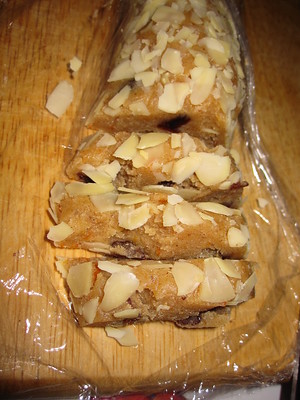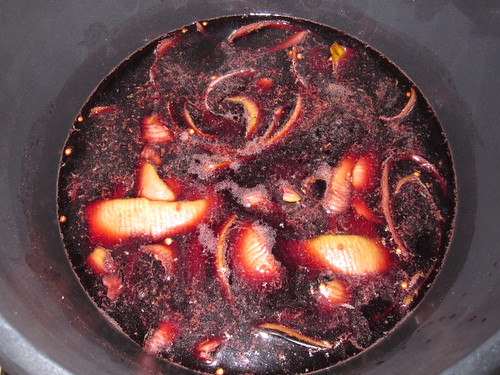The second thing I planned to make was a Swedish twist on an Italian dessert, saffron pannacotta with gingersnap crumbs.
Again a Swedish recipe I stumbled across while looking for something else. We'd run out of gingersnaps, so I had to make some more. Despite two gingersnap baking sessions in December, I still had quite a lot of dough left and I'd frozen it in two chunks. I took one out and let it thaw in room temperature, while I was working on Falbala's cake.
As the number of vegetarians in my family keeps growing, I have to make adjustments to recipes I cook, as we're not talking about "regular" vegetarians here. Lundulph's younger brother eats dairy, but no fish. Lundulph's older brother's girlfriend however does eat fish and shellfish as does my Mother (who also eats turkey at New Year's Eve). My older niece went quickly from meat eater to vegetarian to vegan a few months ago and my sister Bip has been trying to go vegan for a few weeks, with the resolution to do 20 days in January. So things are getting complicated to say the least, but in a good way.
Thus, the thing I had to take out is the gelatin and I bought the only alternative available in the supermarket - Vege-gel from Dr Oetker. The instructions on the packet clearly stated that it is not a substitute, but an alternative and that one would need to experiment to get things right. Well, I didn't have the time for this. Out of the 3 sachets in the packet, I opted to use 2, which would set about 1 litre of liquid. Now I also checked the webpage and here some confusion appeared. One set of instructions said to dissolve one sachet in 200 ml water, heat up and mix it into the recipe. The other set said to dissolve into 200 ml of liquid, heat up and add to the recipe. Hm... well, I didn't want to dilute my pannacotta with water, so I set aside 200 ml of the cream and heated up with both sachets, before stirring into the rest of the mixture. This worked OK. One piece of crucial information that both the packet and the website provided was that the vege-gel sets quickly, so one needs to have everything ready beforehand. Let's say, I just about managed to distribute the liquid into the moulds, the last one only looked like scrambled eggs, but that was OK.
This is good to know - the first time I played with gelatin, I didn't realise it would take hours to set, so all my ideas of making fancy jellies have not come to fruition simply because I'd need days to get them made.
I didn't replace the cream as my vegan niece wouldn't be at the meal, I would have otherwise. So here we go:
Ingredients
Makes 14 - 15 portions
1.2 litre whipping cream
0.5 g saffron
1.5 dl caster sugar
2 vanilla pods
1.5 sachets (6.5 g each) vege-gel
5 - 6 gingersnaps
Method
- Set aside 200 ml of the cream and place the remainder in a saucepan.
- Place the saffron in a pestle and mortar together with some of the sugar, then grind as finely as possible and add to the cream along with the remainder of the sugar.
- Split the vanilla pods in half and scrape off the seeds, then add both seeds and pods to the saucepan.
- Stir things through and bring to the boil.
- In a smaller saucepan, heat up the saved cream and stir in the vege-gel and bring to the boil.
- Pour over the dissolved vege-gel to the main saucepan and stir through to distribute.
- Pour into serving glasses or moulds and chill in the fridge for at least an hour.
- Put the gingersnaps into a sturdy food bag and break into crumbs with a rolling pin. Alternatively place the gingersnaps in a food processor and pulse for a few seconds. Sprinkle before serving.
I recommend that you taste the mixture as it's cooking and make adjustments. The flavours will intensify after the pannacotta has set, especially the saffron. It might also feel rather rich, so perhaps using 6 dl of single cream and 6 dl might make it a little lighter. It reminded me of kulfi in its creaminess.
Lundulph's comment was that this pannacotta didn't pass the "zero resistance test", namely that when you put your spoon through it, it should feel like it's moving through the air - no resistance. But, it should hold its shape and wobble when wobbled. I must have been particularly lucky with my previous attempt with this fabulous dish. Perhaps I should have used that recipe and just added saffron and vanilla. Anyway, I've tried to make adjustments in the ingredients' list above.
The plan was to have the pannacotta as dessert for our first family meal in 2014. Sadly this was not to be, Lundulphs parents had to leave before the dinner was ready and our first family dinner for the year was a bit subdued.
One thing I did however is tag onto a new fashion in gingersnaps. It was a joke-gift from my Mum for Christmas, but I thought I'd give them a try and after a couple of mishaps, they actually worked. Here are the basic shapes - a Christmas tree, a star and a Yule Goat.
I worked out that I need to use a bit more flour during rolling out of the dough, so that the shapes don't get deformed when moving them to the baking tin. Another thing to be careful with on the Christmas trees in particular was that the two slots open out a bit. I'd placed the first pair of Christmas tree parts so that the slots were too narrow and I couldn't put them together. But the ones after that worked fine.
I didn't have time to decorate them, it was just to try out the new cutters. They are from IKEA, if anyone is interested.
Even more surprisingly a couple of them stood up after several days, absolutely amazing in the UK, especially given that it hasn't stopped raining for many days and half the country is under water.





